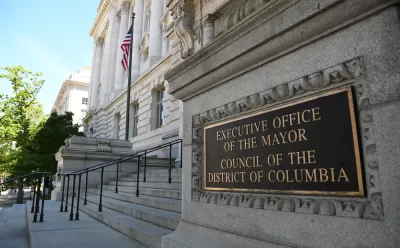A new effort to counter the disproportionate impacts of the pandemic and the systemic inequalities that long predated the pandemic is underway, with new leadership, in the nation's capital.

Washington, D.C. Mayor Muriel Bowser has appointed the District's first Chief Equity Officer to lead a newly created office in the D.C. government dedicated to racial equity initiatives. Debbie Truong reports the news for DCist.
Amber Hewitt, the director of health equity at Families USA, will take on the new role, charged with the immediate task of leading the recovery from the COVID-19 pandemic, which has disproportionately hurt Black, Latino and low-income families in the District.
"Hewitt will lead the city’s Office of Racial Equity, which Bowser established earlier this year. The office is responsible for creating processes that insure city programs and policy decisions are evaluated for equity," according to Truong. "The Office of Racial Equity was established through the REACH Act, a sweeping measure passed by the D.C. Council last year to tackle historic inequities in education, health, housing and criminal justice."
FULL STORY: Bowser Appoints D.C.’s First Chief Equity Officer

Trump Administration Could Effectively End Housing Voucher Program
Federal officials are eyeing major cuts to the Section 8 program that helps millions of low-income households pay rent.

Planetizen Federal Action Tracker
A weekly monitor of how Trump’s orders and actions are impacting planners and planning in America.

Ken Jennings Launches Transit Web Series
The Jeopardy champ wants you to ride public transit.

Rebuilding Smarter: How LA County Is Guiding Fire-Ravaged Communities Toward Resilience
Los Angeles County is leading a coordinated effort to help fire-impacted communities rebuild with resilience by providing recovery resources, promoting fire-wise design, and aligning reconstruction with broader sustainability and climate goals.

When Borders Blur: Regional Collaboration in Action
As regional challenges outgrow city boundaries, “When Borders Blur” explores how cross-jurisdictional collaboration can drive smarter, more resilient urban planning, sharing real-world lessons from thriving partnerships across North America.

Philadelphia Is Expanding its Network of Roundabouts
Roundabouts are widely shown to decrease traffic speed, reduce congestion, and improve efficiency.
Urban Design for Planners 1: Software Tools
This six-course series explores essential urban design concepts using open source software and equips planners with the tools they need to participate fully in the urban design process.
Planning for Universal Design
Learn the tools for implementing Universal Design in planning regulations.
Ada County Highway District
Clanton & Associates, Inc.
Jessamine County Fiscal Court
Institute for Housing and Urban Development Studies (IHS)
City of Grandview
Harvard GSD Executive Education
Toledo-Lucas County Plan Commissions
Salt Lake City
NYU Wagner Graduate School of Public Service





























